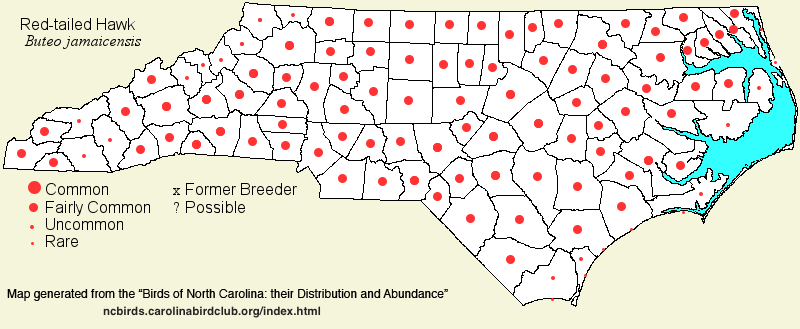 |  |
|
Red-tailed Hawk - Buteo jamaicensis ACCIPITRIDAE Members: | Search Common: Search Scientific: |
|
|
|||||||
| General Comments | The Red-tailed Hawk is the state's most familiar hawk, easily seen perched in trees visible from highways, or soaring overhead. Populations across the state seem to have remained stable over the past few decades, though have been surpassed in recent decades by the slightly smaller Red-shouldered Hawk. It might be the only hawk that indisputably breeds in every county in the state. Red-tails favor a mix of forests and fairly large fields, nesting quietly in trees inside the forest, but spending most of their time foraging in fields and roadsides, both observing prey from soaring overhead or from a high perch in a tree. There are numerous reports of various color phases, which are beyond the scope of this reference, in part because there is so much variation in plumages/pigments in this species. There are a few reports of the Harlan's subspecies, including a specimen at the NC Museum of Natural Sciences that is identified as this subspecies; however, to date only two records have been accepted by the NC BRC. | ||||||
| Breeding Status | Breeder | ||||||
| NC BRC List | Definitive | ||||||
| State Status | |||||||
| U.S. Status | |||||||
| State Rank | S5B,S5N | ||||||
| Global Rank | G5 | ||||||
| Coastal Plain |
Permanent resident, with some migratory movements. Fairly common breeder in the western half of the province, and uncommon to fairly common in the eastern half, though rare to absent as a breeder on most coastal islands; numbers increase in fall and winter, and it becomes generally common across the province in winter, though only small numbers winter along coastal islands. Peak counts:
Harlan's Hawk: a light-phase adult Harlan's Hawk was seen at Alligator River NWR on 2 Mar 2012* [Chat 76:109 link]; it was accepted by the NC BRC [Chat 77:6-10 link]. | ||||||
| Piedmont |
Permanent resident, with some migratory movements. Fairly common summer resident, and common winter resident, across the province. Peak counts:
Harlan's Hawk: an adult male specimen, from Charlotte (Mecklenburg) on 13 Jan 2003*, is now at the NC Museum of Natural Sciences. The NC BRC accepted photos of the specimen [Chat 78:8-13 link]. | ||||||
| Mountains | Permanent resident, with some migratory movements. Fairly common at low elevations (below 2,500 feet) year-round; uncommon to fairly common all year at mid-elevations (2,500-4,500 feet); and scarce at high elevations at any time. However, there is a noticeable fall flight, when the birds can be occasionally common (at least from hawk watches) in Oct and Nov. Peak counts: | ||||||
| Finding Tips |
This and the Red-shouldered Hawk are the most frequently seen large hawks in the region; it is difficult to miss either species in a full day of birding, especially in winter. *** to **** | ||||||
| Attribution | LeGrand[2023-03-21], LeGrand[2014-05-16], LeGrand[2013-05-25] | ||||||
| NC Map Map depicts all counties with a report (transient or resident) for the species. | Click on county for list of all known species. |
| NC Breeding Season Map Map depicts assumed breeding season abundance for the species. |  |